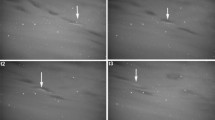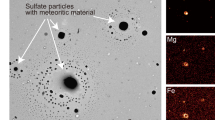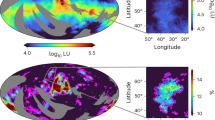Abstract
AT Ilford, Essex, on the 17th instant, at 6h. 4m. p.m. by a watch which was within 2m. of G. M. T., I witnessed, during the auroral display, the extremely singular phenomenon which has been described by several of your correspondents. It looked exactly like a white cloud, about 20° long and 2° wide, tapered somewhat from the middle to each end; but it was more luminous than a cloud could well have been at that time. When first seen, its nearest end may have been 30° east of the moon. Its length was nearly parallel to the horizon, and continued so till lost sight of about as much to the west of the moon; and its passage over an area of some 80° occupied probably less than a minute. It passed very near to the moon, but I cannot say whether over it or not.
This is a preview of subscription content, access via your institution
Access options
Subscribe to this journal
Receive 51 print issues and online access
$199.00 per year
only $3.90 per issue
Buy this article
- Purchase on SpringerLink
- Instant access to full article PDF
Prices may be subject to local taxes which are calculated during checkout
Similar content being viewed by others
Author information
Authors and Affiliations
Rights and permissions
About this article
Cite this article
TAYLOR, C. The Aurora. Nature 27, 99–100 (1882). https://doi.org/10.1038/027099d0
Published:
Issue date:
DOI: https://doi.org/10.1038/027099d0



